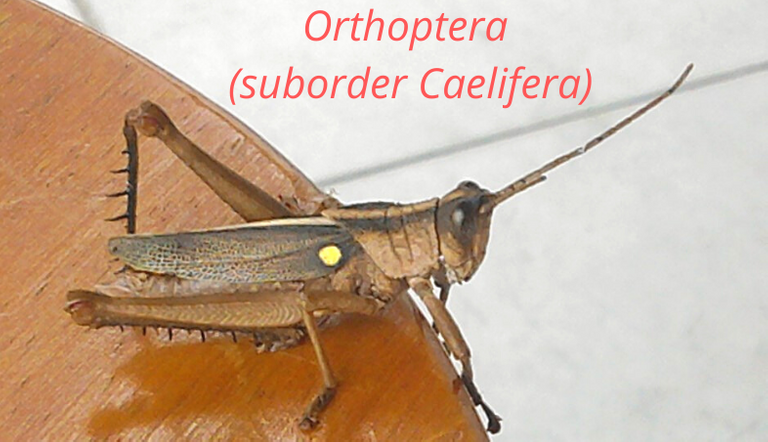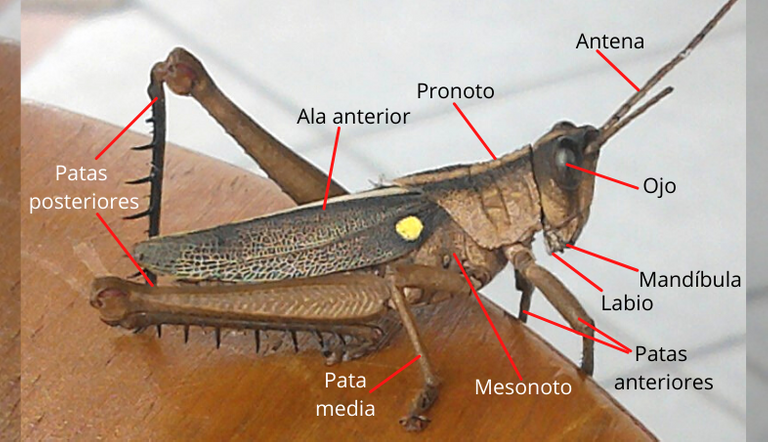Greetings dear community is a pleasure for me to share my publication here today since it is the first time I do it but the occasion deserves it.
Saludos querida comunidad, es un placer para mi compartir hoy mi publicación aquí, ya que es primera vez que lo hago pero la ocasión lo amerita.

A few days ago, I came across this insect that you see in the photo above. I have respect for insects, but they also cause me aversion. However, I want to share with you that when I saw this specimen so rare, at least for me, I photographed it and decided to investigate it.
The first thing that surprised me is that this insect was perched on a table of a very similar color to him but still could be distinguished as I know that there are several that mimic so that they can not be observed easily. However, it is a very fast insect since I could take only a couple of photos that allowed me to appreciate its curious morphology.
In the photograph I share with you, you can see an Arthropod of the Class Insecta, of the order Orthoptera and suborder Calliptera, popularly known as grasshoppers. I was amazed by this specimen. The grasshoppers I had seen were green in color, and this one, in addition to being brown had a distinctive yellow circle on its wing. This coloration was symmetrical on both the left and right sides. To determine what kind of insect it was, I turned to an expert friend in the area, my dear @abneagro, who has the warmth and unique pedagogy that makes you start to love these living beings despite the aversion.
Hace unos días me encontré con este insecto que ven en la foto superior. Personalmente les tengo respeto a los insectos pero también me causan aversión, sin embargo les quiero compartir que al ver este ejemplar tan raro, al menos para mí, lo fotografíe y decidí investigar sobre él.
Lo primero que me sorprendió es que a pesar de posarse en una mesa de un color muy similar a él pudiese distinguirse ya que sé que hay insectos que se mimetizan para evitar ser vistos. No obstante es un insecto muy veloz, ya que pude sacarle solo un par de fotos pero éstas me permitieron apreciar en su totalidad su curiosa morfología.
Para determinar de qué clase de insecto se trataba acudí a un amigo experto en el área, mi querido @abneagro quien posee la calidez y la pedagogía única que hace que puedas empezar a querer a estos seres vivos a pesar de la aversión.
En la fotografía del insecto que les comparto se visualiza un Artrópodo de la Clase Insecta, de la orden Ortóptera y del suborden Calífera, conocidos popularmente como saltamontes o chapulines. Quedé sorprendida ya que los saltamontes que había visto hasta ahora eran de color verde y este ejemplar además de ser marrón tenía un círculo distintivo de color amarillo en su ala anterior. Esta coloración era simétrica se encontraba tanto de lado izquierdo como derecho.



As I searched for information, I realized that this is an insect with many developed anatomical structures, and my photo allowed me to locate several of them. Orthoptera of the suborder Calliptera has a well-defined head, antennae, eyes. Its thorax has three segments (pronotum, mesonotum, metanotum), abdomen, wings, and 3 pairs of legs. The forelegs are shorter and thinner than the middle legs. The hind legs are of a more robust structure designed for jumping. This insect has a highly developed jaw structure and allows it to chew, a function I had no idea they could perform. The grasshopper was perched on its abdomen making it difficult to identify in the photograph taken.
The most curious thing I discovered was the scientific name and the mechanism of the sound that grasshoppers produce, just like their relative's crickets but of the suborder Ensifera. These insects are provided with structures at the upper level of the thorax (pronotum), like scales that move along the surface of the middle part of their thorax (mesonotum), which has undulations. This friction between both structures originates vibrations that emit the sound. This sound is known as stridulation.
For me, it was an adventure to meet this grasshopper and learn more about it, confirming once again that nature is amazing.
Al buscar información me percaté que es un insecto con muchas estructuras anatómicas desarrolladas y mi foto permitió que pudiese ubicar varias de ellas. Los Ortópteros del suborden Calífera tienen una cabeza bien definida, antenas, ojos, tórax el cual de divide en tres segmentos (pronoto, mesonoto, metanoto), abdomen, alas y 3 pares de patas. Las patas anteriores son más cortas y delgadas que las medias. Las patas posteriores son de estructura más robusta diseñadas para saltar. Este insecto tiene una estructura mandibular muy desarrollada ya que le permite masticar, función que no tenía idea que podían realizar.El saltamontes se encontraba posado sobre su abdomen haciendo difícil identificarlo en fotografía tomada.
Lo más curioso fue descubrir el nombre científico y el mecanismo del sonido que producen los saltamontes al igual que sus parientes los grillos pero de suborden Ensifera. Estos insectos están provistos de unas estructuras a nivel superior del tórax (pronoto) como especie de escamas las cuales se desplazan por la superficie de la parte media de su tórax (mesonoto) la cual posee ondulaciones pequeñas. Este roce entre ambas estructuras origina vibraciones que emiten el sonido. Este sonido se conoce como estridulación.
Para mí fue toda una aventura este encuentro fortuito con este saltamontes y conocer más acerca de él confirmándome una vez más que la naturaleza es maravillosa.

All photographs are the property of the author.
Gracias por leerme.
¡Nos vemos en la próxima publicación!
Todas las fotografías son propiedad de la autora.
